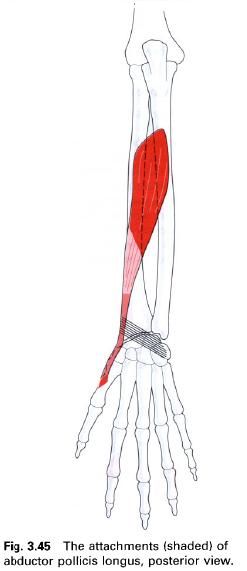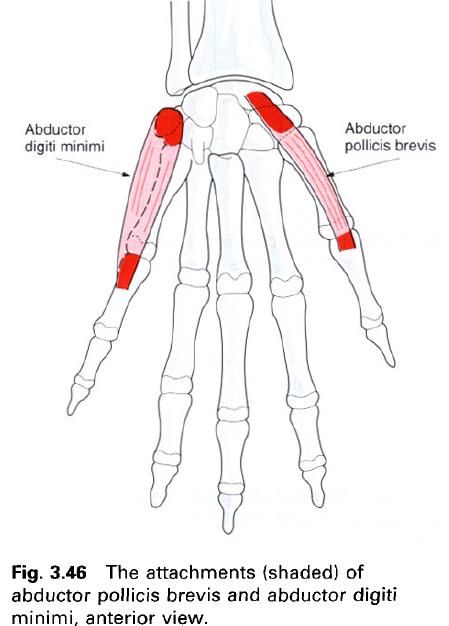Abductor pollicis longus
Abductor pollicis brevis
Opponens pollicis
Adductor pollicis
Palmaris brevis
Abductor pollicis longus
Abductor pollicis longus lies deep to extensor digitorum in the posterior compartment of the forearm. It
arises from the upper part of the posterior surface of the ulna below anconeus, the
middle third of the posterior surface of the radius below supinator
and the intervening interosseus membrane.
As the muscle passes distally, it emerges from
its deep position to lie superficially in the lower part of the forearm. The
tendon forms above the wrist and passes, with that of extensor pollicis brevis, with the same synovial sheath below the
extensor retinaculum, where it lies in a groove on the lateral surface of the
radial styloid process. The tendon inserts primarily into the radial side of
the base of the first metacarpal, with a slip which passes to the trapezium,
and another which passes to abductor pollicis brevis and the fascia over the
thenar eminence.
Nerve
supply
Abductor pollicis longus is supplied by the
posterior interosseus branch of the radial
nerve, root value C7, 8. The skin over the muscle is supplied by roots C6,
7.
Action
By itself, the muscle puts the thumb into a mid-extended and abducted
position. Working with the extensors, abductor pollicis longus helps to extend
the thumb at the carpometacarpal joint, while, with abductor pollicis brevis,
it abducts the thumb.
Palpation
Palpation of this muscle is described with extensor pollicis brevis.
Abductor pollicis brevis
Abductor pollicis brevis is the most lateral
and superficial of the three muscles forming the thenar eminence. It takes its
origin mainly from the front of the flexor retinaculum, extending onto the
tubercles of the scaphoid and trapezium with an occasional
contribution from the tendon of abductor pollicis longus. The muscle forms a
short tendon which attaches to the radial side of the base of the proximal
phalanx of the thumb, with some fibres reaching the expansion of the extensor
pollicis longus tendon.
Nerve
supply
Abductor pollicis brevis is supplied by the median nerve, root value T1. The skin
over the muscle is supplied by root C6.
Action
Abductor pollicis brevis abducts the thumb at both the carpometacarpal and
metacarpophalangeal joints, causing it to move anteriorly at right angles to
the palm. In order to achieve this position there must be some medial rotation
at the carpometacarpal joint, the remainder occurring at the metacarpophalangeal
joint. This movement is of great significance in terms of the function of the hand as the thumb can be moved towards
the fingertips(opposition) where it can carry out precision tasks that require
a pincer grip. Because of its partial insertion into the long extensor tendon
of the thumb, abductor pollicis
brevis can aid in flexion of the metacarpophalangeal joint and extension of the
interphalangeal joint.
Opponens pollicis
Opponens pollicis is covered by abductor
pollicis brevis. Arising from the flexor retinaculum and tubercle of the
trapezium, it inserts into the whole length of the lateral half of the anterior
surface of the first metacarpal.
Nerve
supply
Opponens pollicis is supplied by the median nerve, root value T1.
Occasionally, it may be supplied by the ulnar
nerve. The skin over the muscle is supplied by root C6.
Action
Opponens pollicis produces the complex
movements of the thumb called
opposition where the first metacarpal is drawn forwards and medially in an arc
towards the fingers. The movement involves, in order of action, abduction,
medial rotation, and finally flexion and adduction at the carpometacarpal joint
of the thumb. The importance of this action is that the tip of the thumb can be
brought into contact with the tip of any finger, thus allowing for very precise
action of the hand.
Palpation
The three muscles forming the thenar eminence
of the thumb are closely packed together and covered with tough fascia which
makes identification of individual muscles difficult. However, if the thenar
eminence is carefully palpated during resisted movements, all but opponens
pollicis can be identified. If abduction of the thumb is resisted(that is
movement away from the palm in a plane of 90° to the palm) abductor pollicis
brevis can be identified in the lateral part of the thenar eminence.
Adductor pollicis
Adductor pollicis is found in the web space of
the thumb on its palmar aspect, and
has oblique and transverse heads. The oblique head arises from the sheath of
the tendon of flexor carpi radialis,
the bases of the second, third and fourth metacarpals, and the trapezoid and
capitate bones. The transverse head arises from the longitudinal ridge on the
anterior surface of the shaft of the third metacarpal. Between these two heads,
the radial artery passes to gain access to the palmar aspect of the hand. Both heads are inserted into the
medial side of the base of the proximal phalanx of the thumb by a tendon containing a sesamoid bone.
Nerve
supply
Adductor pollicis is supplied by the deep
branch of the ulnar nerve, root value
C8 and T1. The skin over the muscle is supplied by roots C6 and 7.
Action
Adductor pollicis is a strong muscle that
brings the thumb back to the palm
from a position of abduction. Also, it is active in the later stages of
opposition. Functionally, the strength of this muscle can be demonstrated when
the tip of the index finger and thumb are held together in a pincer grip and an
attempt is made to pull them apart. Consequently, adductor pollicis is an important
muscle in maintaining the precision grip of the hand.
Palpation
Adductor pollicis is found in the web between
the thumb and index finger, and can be felt on the palmar aspect when the
movement of adduction is resisted.
Palmaris brevis
Palmaris brevis is a superficial muscle found
covering the hypothenar eminence of the little finger. It arises from the
medial border of the palmar aponeurosis and the front of the flexor retinaculum
and inserts into the skin of the medial border of the hand.
Nerve
supply
Palmaris brevis is supplied by the superficial
branch of the ulnar nerve, root value
T1. The skin over the muscle is supplied by root C8.
Action
Contraction of the muscle wrinkles the skin on
the ulnar side of the hand. This
muscle is included in this section as its main function is to assist the thumb
in producing a good grip.












0 коментара:
Постави коментар